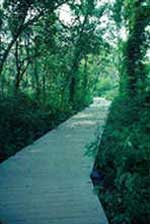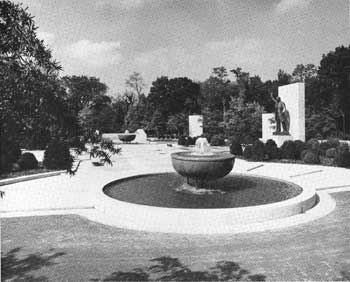






Survey of
Historic Sites and Buildings
 |
Theodore Roosevelt Island Park District of Columbia |
 Roosevelt Island |
| ||
An 88-acre natural area in the Potomac River, this island serves as an appropriate tribute to the conservation activities and interests of President Theodore Roosevelt. Although primarily a plant and wildlife preserve, it is also the site of a monument honoring his Presidency and other accomplishments.
The first white men to explore the island called it "Anacostian" or "Analostan," derivations of a local Indian name. After 1632, when King Charles I of England granted it to Lord Baltimore as part of Maryland, it became known as "My Lord's Island." Capt. Randolph Brandt, who acquired it in 1681, renamed it "Barbadoes" after his home in the West Indies. The next purchaser, in 1717, was George Mason, father of the well-known Virginia constitutionalist of the same name. For more than a century, "Mason's Island" was one of the finest farming estates in the region. John Mason, grandson of the purchaser, built there a fine brick mansion, which no longer exists. Following construction of a causeway to the Virginia shore in 1805, stagnant water began to create unhealthful conditions, and about 1832 the Masons departed; later, floods washed away the causeway.
Subsequent owners included the Columbia Athletic Association, the Analostan Boat Club, and the Washington Gas Light Company. In 1931 the Theodore Roosevelt Memorial Association bought the island and offered it as a gift to the American public in memory of Roosevelt. The next year, Congress accepted the gift.
 |
| Memorial area at Theodore Roosevelt Island. (National Park Service, Jack Rottier, 1967.) |
For many years, plans to erect a memorial on the island came to naught. Finally, however, in 1960 the National Park Service acquired funds for a monument, constructed between 1963 and 1967. Designed by Eric Gugler, it is in the center of the northern part of the island. It features a 17-foot-high bronze statue of Roosevelt, executed by Paul Manship, in front of a 30-foot-high granite shaft overlooking an oval sunken terrace. A water-filled moat, crossed by footbridges, surrounds the terrace. Rising from the latter are four 21-foot-high granite tablets inscribed with Roosevelt quotations.
To facilitate access to the island, the National Park Service has constructed a pedestrian causeway from the Virginia shore. Three natural environments—upland forest, swamp, and marsh—provide refuge for a variety of plants and wildlife, which may be observed via a 2-1/2-mile network of trails.
 |
 |
http://www.cr.nps.gov/history/online_books/presidents/site11.htm
Last Updated: 04-Feb-2004